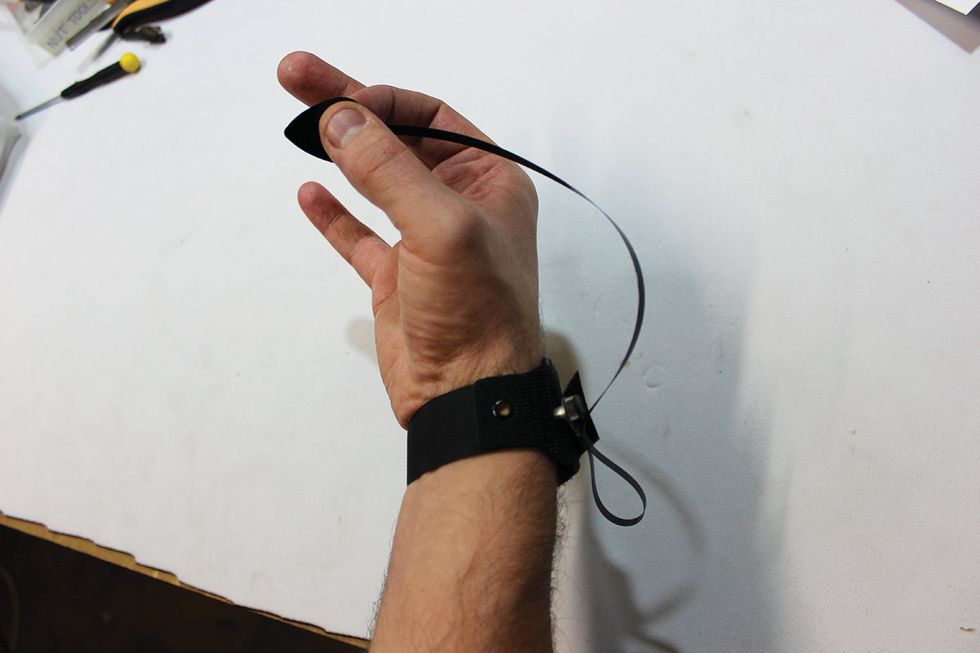Last time out, we explored the strengths and weaknesses of the most common types of sensors used to generate MIDI data (“The Pros and Cons of Pitch-to-MIDI Technologies”). Now it’s time to dig even deeper and celebrate a pioneer of MIDI bass, Australian Steve Chick.
In the early ’80s, while Roland focused on their right-hand-driven, pitch-to-voltage MIDI technology, Chick was developing a system using split frets to generate MIDI data with the player’s left hand. This wasn’t the first time split frets were used for triggering. Some might remember the Guitorgan, which was introduced by inventor Bob Murrell at the 1967 Chicago NAMM show as the first instrument to sport a fret-sensing mechanism to trigger organ sounds. The Guitorgan used split frets to detect pitch and then trigger internal organ circuitry. In many ways, it was a precursor to the guitar-synth craze of the late ’80s.
In the early days of MIDI, latency was the key issue of all right-hand sensing systems. Chick knew how to fight the latency problem, but it took him until 1985 to develop his first complete system, which included a secondary magnetic sensor to capture more of the plucking info. Not wanting to be a bass builder, he modified customer instruments and also licensed the system to several manufacturers, including Manton, Wal, and Valley Arts. In 1990, the refined system, named PB1, became the technology behind Peavey’s Midibase and Cyberbass.
—Steve Chick
The system came with programmable presets and measured tension at each string to detect pitch bends. The days of these basses are long gone, but Chick is still active at Industrial Radio, which he founded in 2009. He has spent a lifetime working with MIDI bass, so it’s worth examining how far his system has come and what he sees as the main problems facing low-enders that want to trigger electronic sounds.
Here’s what Chick has to say about this in 2018: “The crazy thing about the science of MIDI bass is that everyone is fixated with latency. It is really important. I solved that problem over 30 years ago, but the ultimate challenge is right-hand triggering and dynamics. It’s the really hard problem to solve.”
Sold under the Industrial Radio brand, Chick’s current line of basses incorporates his fret-sensing technology, as well as individual piezos linked to digital signal processing designed to analyze their signals. Without going into too much detail, the hardware and software clean up unwanted noise from the signal, while preserving playing dynamics and respecting intentional notes and sounds. One of the adjustable parameters is “aperture,” which essentially measures sensitivity over a time interval. A high-pass filter controls how much low, “rumbling” frequencies get through, while a low-pass filter screens for fret noise that could produce unwanted triggering.
Plucking detection is just where you’d expect it—in the pick itself. Photo courtesy of industrialradio.com
Although all these parameters can be adjusted independently, the software comes with presets that reflect Chick’s decades of experience dealing with our messy signals. His research shows that there is far more to it than just right- or left-hand sensing, and Photo 1 revealshow complicated a hybrid system can get.
Because dialing in all these parameters to accommodate a bassist’s personal playing style takes time, there was another lesson to be learned. “In the process of demonstrating MIDI bass systems over the years,” Chick says, “I noted that players expected instant results in performance.”
This realization ultimately led to another type of sensor designed to deliver immediate gratification to the antsy novice. And this device is located precisely where one might expect plucking detection in the first place: our right hand. The RadioPick (Photo 2) is essentially an electronic plectrum that sends a trigger signal each time it hits a string. The wristband transmits these signals via radio frequencies to specific sensors within the instrument. Perhaps if we all played with flawless technique, the RadioPick would be unnecessary. But we don’t, so it has to pick up the slack and clean up our technique for us.









![Rig Rundown: AFI [2025]](https://www.premierguitar.com/media-library/youtube.jpg?id=62064741&width=1245&height=700&quality=70&coordinates=0%2C0%2C0%2C0)












 Shop Scott's Rig
Shop Scott's Rig![Rig Rundown: Russian Circles’ Mike Sullivan [2025]](https://www.premierguitar.com/media-library/youtube.jpg?id=62303631&width=1245&height=700&quality=70&coordinates=0%2C0%2C0%2C0)















































